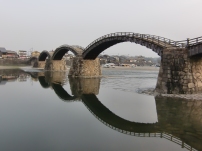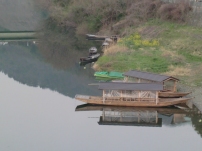 Writer-philosopher Alain de Botton suggested in his book “The Art of Travel” that images of places can make us want to visit them. It is the sense of “I want to see that for myself”. Iwakuni’s Kintaikyo bridge is definitely such a place!
Writer-philosopher Alain de Botton suggested in his book “The Art of Travel” that images of places can make us want to visit them. It is the sense of “I want to see that for myself”. Iwakuni’s Kintaikyo bridge is definitely such a place!
Its five arched spans invoke a sense of mystery. When was it built? Why here? Why did they make it this way? What would it feel like to walk across? Some of these questions are easier to answer than others.
The bridge was first built in 1673, looking pretty much the way it does today. The solid stone piers anchoring each arched wooden span help to prevent the bridge from being washed away in the frequent floods of the Nishiki River. In fact the first bridge was washed away in less than a year, but the re-built bridge stood for 276 years, until a 1950 typhoon/flood washed it away. To be fair, the bridge was then in a weakened state, as it had not been maintained during WWII and after the war the US Marines had removed a lot of gravel from the river bed for the construction of a nearby base.
The original (ie, 1674) bridge, was built without using any nails and was constructed in such a way that weight on the arches compressed the wood together, just making it stronger. On the surface of the bridge, the steepest part of the slopes of each arch are steps.
Historically, the bridge was carefully maintained, with the arches being replaced periodically (similar to the way the shrines of Ise are regularly rebuilt to their original specifications). After the bridge was destroyed in 1950, a citizen movement saw it rebuilt, again to original specifications, except that this time metal nails (made of the same metal Japanese katana swords are forged from) were used to ensure durability. The bridge is now a designated national treasure.
There was a time when only those of the “samurai” class were permitted to cross the bridge and “commoners” would have to cross the river by boat. These days, anyone can walk across the bridge, although boat rides on the river are also possible. In season, cormorant fishing shows also take place.
Crossing the bridge from the left bank is free of charge. A donation is requested on the return trip, but only during business hours, as the donation booth closes in the evening, while the bridge remains open all hours.
Beautiful as it is, we still have the question of why have a bridge there in the first place. Most of the town of Iwakuni sits between the left bank of the river, between the river and the bay on the Seto Inland Sea. But high above the right bank, on Mt. Shiroyama, sits Iwakuni Castle, the historical seat of the Kikkawa daimyo clan.
Like most castles in Japan, this is a reconstruction, but worth making a trip up the mountain to see, especially since there is a ropeway that will take you there effortlessly. Of course, the wooded mountainside has plenty of hiking trails, so you can also walk up and enjoy the scenery. In that case, take the opportunity to explore some of the historical temples of the area as well.
Below the castle, nearer to the river, was the Kikkawa family residence. This complex is the real reason for the construction of the bridge. The site is now known as Kikko Park. It is replete with interesting sights, including the samurai residence and an area inhabited by white snakes, which are indigenous to the area. White snakes are said to be the messengers of the goddess Benten.
Iwakuni is just a little off the beaten track for foreign tourists, but can easily be visited in combination with a visit to Hiroshima and/or Miyajima. Kintaikyo bridge is a 20 minute bus ride from Iwakuni Station. There are several nice hotels overlooking the bridge/river, if you decide to stay overnight.
















